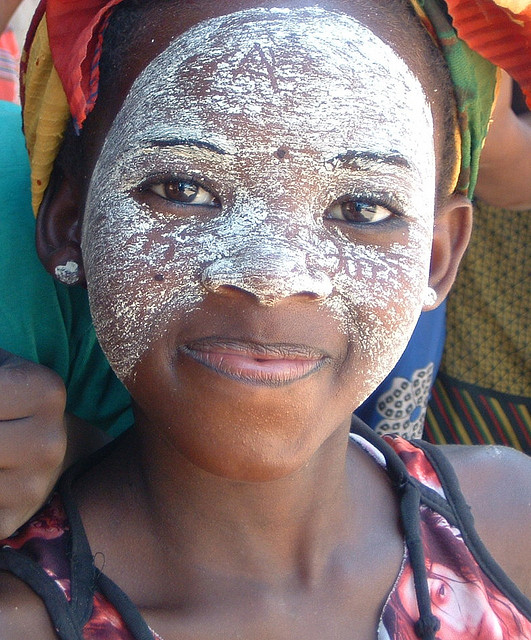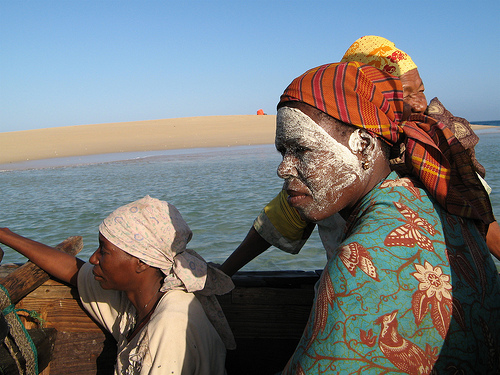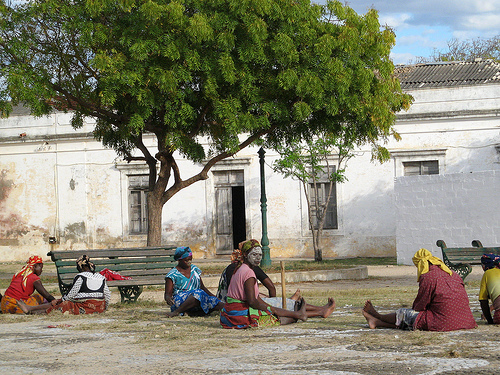In the northern coastal region and islands of Mozambique, it's common to come across women with faces covered with a natural white mask, called mussiro or n’siro. The purpose of the mask seems to have evolved over time. Nowadays it tends to be considered more as a means of beautifying the skin, but according to oral accounts, mussiro masks used to carry other subliminal messages related to the civil status of women.
While some meanings might have been lost through history, we pay homage to Mozambican women through this article on what some consider to be one of the strongest brand images of the country.
Matope Jose, from Mozmaníacos, wrote[pt] about the mussiro tradition:
A província de Nampula é tradicionalmente conhecida como a terra das “muthiana orera” ou, simplesmente, meninas bonitas. As mulheres daquela região do país possuem uma técnica que lhes é peculiar de tratar da pele, desde tenra idade, com recurso a uma espécie florestal bastante procurada, denominada mussiro, uma planta que consta da lista das que devem ser preservadas e multiplicadas e que, regra geral, são usadas pelas comunidades para cura de diversas enfermidades, bem como para fins decorativos.
In the following video [pt] by Julio Silva, women from Angoche explain how the tradition has been passed down to today's generation from their grandparents, and they show how the cream is extracted from the Olax dissitiflora plant using a stone and some water:
É esta planta é que nós usávamos na cara como mussiro. É como está a ver na minha cara, é esta planta.
Eu sou Fátima natural de Angoche. Este musiro nossos avós pintava primeiro uma pessoa quando é virgem. Depois entrava dentro de uma casa. Depois pintava este mussiro para ficar branca, até vir um namorado para namorar e casar-se com ele é que deixava mussiro. Só depois, para fazer assim este mussiro, depois uma pessoa quando está fora para ficar clara, para ficar bonita a cara. É este o mussiro. A planta está no mato. Nós costuma ir buscar nossos marido, o bisavô vão cortar e isto começa aí vender. Agora vou mostrar a maneira como se faz este mussiro.
I am Fátima, from Angoche. This mussiro, our grandparents first used it to show when a girl was a virgin. Then she would enter a house. They painted themselves with this mussiro to become white, until a boy came along who they fell in love with and married; only afterwards did they stop using the mussiro. Only afterwards, they use the mussiro like this, when someone is outside, in order to be white, to make their faces beautiful. This is mussiro. The plant is in the forest. While we usually go and meet our husbands, the great grandparents go and cut it and start selling it. Now I will show you the way we make the mussiro.
A post [pt] on the Baía magazine website adds that the tradition of mussiro being used by virgins or by women whose husbands were away is no longer its only usage:
Actualmente, esta pasta está massificada e “liberalizada” para todas as mulheres do norte a sul do país podendo ser usada não só pela mulher makwa ou makonde, mas também a manhungue, machuabo, maronga, machope, matswa etc. É já considerado um tratamento de beleza usado por todas aquelas mulheres preocupadas de forma especial com a beleza feminine africana. Algumas estilistas apostam as suas modelos a usarem esta “pasta afro” nas grandes passarelas como é o caso de Mozambique Fashion Week.









